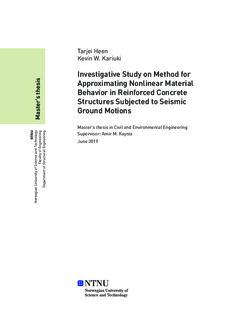| dc.description.abstract | Ikke-lineære tidsplansanalyser blir generelt ansett som den mest nøyaktige metoden for å anal- ysere responsen til konstruksjoner utsatt for seismiske laster. Dessverre er denne typen analyser svært krevende beregningsmessig, samt at det er nødvendig med passende spesialiserte verk- tøy. Målet med denne masteroppgaven er derfor å undersøke nøyaktigheten og brukbarheten av Sekantmetoden. Dette er en elastisk analyse, hvor de ikke-linære effektene i konstruksjonens materale blir tatt hensyn til gjennom bruken av sekantstivheter. Oppgavens fokus er rettet mot det søndre brutårnet på Chacao Bridge, en hengebru med beliggenhet i Chile. Til denne opp- gaven ble det laget to modeller. Den første er en ikke-lineær fiber modell hvor ikke-lineæriteter i materialene er tatt hensyn til gjennom fordelt plastisitet. I tillegg ble det satt opp en elastisk modell, hvor bøyestivhetene til elementene ble oppdatert iterativt. Videre ble det uført ulike pushoveranalyser med hensikt av å danne et bredere sammenligningsgrunnlag.
Resultatene fra syv ulike tidsplansanalyser viste at Sekantmetoden er egnet til å beregne maksimum av bøyemomentene i konstruksjonen, innenfor en akseptabel feilmargin. Den en- delige reduserte modellen representerer det verste tilfelle for samtlige elementer, og gir derfor en altfor myk konstruksjon sammenlignet med hva som i realiteten er tilfelle på et gitt tidspunkt under et jordskjelv. I tillegg evner ikke metoden å gjenskape lukking av riss i betongen grunnet osillerende svigninger. På grunnlag av dette egner metoden seg kun til å beregne maksmo- menter, og ikke hele responshistorier.
Pushoveranalysene verifiserte Sekantmetodens egnethet til å beregne lastfordelingen i kon- struksjonen fram til et lastnivå hvor knusing av betongen eller flyt i armeringen initieres. Meto- den er likevel nøyaktig nok til å identifisere mulige flyteledd, og til en viss grad vurdere kon- struksjonens duktilitet.
De konkluderende bemerkningene fra denne masteroppgaven viser at Sekantmetoden egner seg til analyser og prosjektering av konstruksjoner, da den evner seg å fange opp de største mo- mentene som opptrer i konstruksjonen. I tillegg egner metoden seg til å beregne lastfordelingen i konstruksjonen før maks kapasitet nås i statiske analyser. På grunnlag av dette konkluderes det med at metoden gir et fullverdig alternativ til analyser ikke-lineær materialoppførsel. Dette er i samsvar med krav fra både Eurokode 8 og AASHTO Guide Specifications for LRFD Seismic Bridge Design. | |
| dc.description.abstract | Nonlinear time history analyses are generally regarded as the most accurate way of predicting the dynamic response of a structure to a given seismic ground motion. Unfortunately, these types of analyses are computationally demanding and requires appropriate software. There- fore, the aim of this thesis is to investigate the feasibility and accuracy of an elastic analysis where material nonlinearities are accounted for iteratively through the use of secant stiffnesses, namely the Secant Method. The structure of focus is the South Pylon of the Chacao Bridge located in Chile. For comparative purposes, two models were created in the open-source frame- work OpenSees: a full nonlinear fiber model where nonlinear material behaviour is accounted for through distributed plasticity, and an elastic model where the element flexural stiffnesses are updated through the use of the Secant Method. For further verification, several pushover analyses were conducted on both models, with the inertial forces from the most unfavourable time-steps from the response histories providing the load distributions in the analyses.
The results from seven averaged response history analyses show that the Secant Method is able to capture the maximum forces in the structure within an acceptable margin. The Secant Method is only able to emulate the stiffness reduction corresponding to maximum moments. The method is not able to capture regaining of stiffness once cracks are closed due to cyclic re- sponses. Additionally, since the maximum moments for each element are picked independently of each other, the reductions obtained should be treated as a worst case scenario. With this in mind, the Secant Method is not recommended for studying the entire response history of the structure and should only be used when maximum responses are to be analyzed.
The pushover analysis verified that the Secant Method was able to predict the response of the structure up until the steel reinforcement yields or crushing of the concrete. Nevertheless, the method was accurate for the loads representing the Most Probable Earthquake event and would be suitable for identifying possible plastic hinges, and to some degree assess the ductility of the structure.
For design purposes, the concluding remarks of this thesis show that the Secant Method is able to accurately predict maximum responses from time history analyses, pre-yielding be- haviour and load distributions in static analyses. Hence, the method is a valid code-compliant option to a full nonlinear analysis, according to requirements from American Association of State Highway and Transportation Officials (AASHTO) Guide Specifications for LRFD Seis- mic Bridge Design and Eurocode 8. | |
